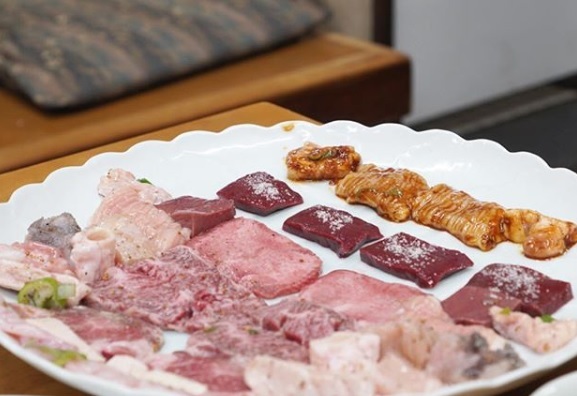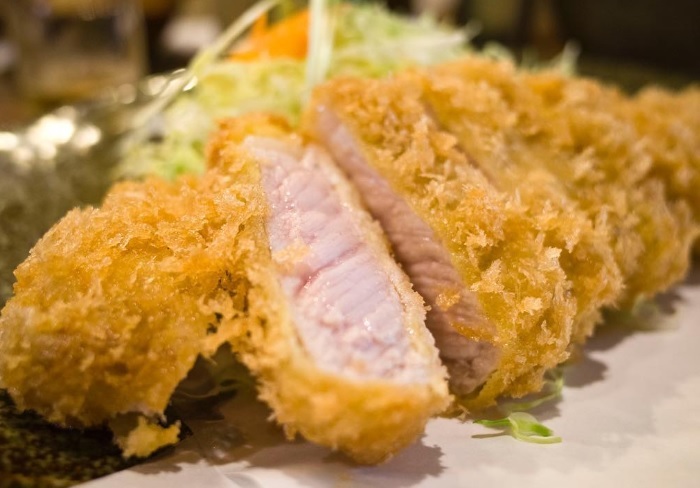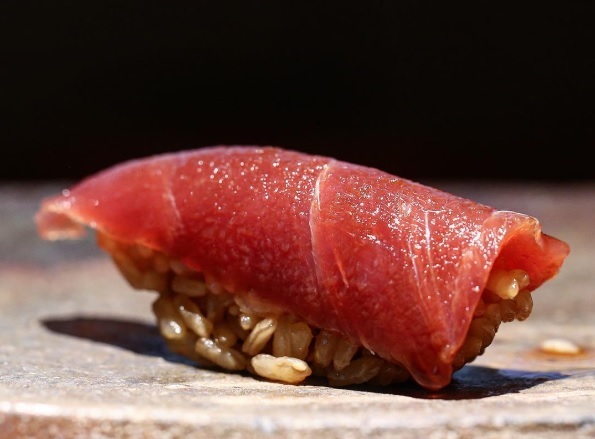A New Michelin 3-star Restaurant in Kyoto.
Maeda is an unassuming restaurant in the historical Gion area. One of my favorite restaurants, Gion Sakagawa, is nearby, so I had wandered in the area many times but had always walked past without noticing Maeda.
It’s a lovely walk in Gion at night, especially near the end of summer and in early fall because of the perfect weather. The walk after dinner in the dark alley passing the old Japanese townhouse is rather magical as I found the ambience quite enchanting.
The reason I had never gotten a chance to visit Maeda sooner was that a minimum party of two guests is required. I would have booked it many times, but sadly, I couldn’t manage to find a dining companion. I tried to get around this rule, but the life of a solo diner proved to be difficult in this case as the restaurant doesn’t accept bookings from solo diners.
Maeda has 10 seats at the counter, so it’s not quite a small restaurant. Chef Maeda runs the show. I noticed that only one sous chef was actively assisting Chef Maeda. The restaurant’s media exposure is quite low, and it has no food photos on Tabelog or Google Maps because of its no photo policy. Therefore, I thought it would be nice to share my fall kaiseki experience at Maeda.
I walked in and saw Chef Maeda; he looked remarkably young. Chef Maeda was, unlike some other chefs who require some warm-up when they encounter foreign customers, very friendly that I felt his warm welcome right away.
I didn’t snap photos or take notes, so I will try my best to relive the experience from my faint memory, and the sequence might not be 100% accurate. I noticed, in my former dining experience, that some Japanese foodies took dining so seriously that some of them even kept a journal of where they visited and what they ate.
My dinner began with aka uni, edamame, and caviar in fish stock. I was so intrigued after the first sip. What an uplifting taste profile! It wasn’t the best timing for aka uni, but what was served was top quality. The next item was fried corn puff. I was warned that the filling was still piping hot. The frying was perfect without any trace of residual oil. The corn filling was smooth as silk, and the mild natural sweetness of the corn was so elegant. Next was harumaki with ayu, which got so much roes. It was an amazing bite. This was my second time having harumaki at a kaiseki restaurant. His frying was spot-on. I also had saba, myoga, and sesame wrapped in top-quality seaweed. His high-quality nori fell apart, melted away in my mouth, and doesn’t stick to the tongue.
For the main dish, my owan is suppon soup and matsutake. It was a perfect marriage between suppon stock and aromatic matsutake. This helped warm my stomach on a cold night. I was so impressed by the taste and aroma of this matsutake.
I was lucky to visit in the fall to experience the king of fall ingredients, matsutake. Besides top-quality seafood, matsutake also has a deep umami flavor. Due to its unique aroma, taste, and texture, Japanese diners look forward to this once-a-year experience.
Matsutake is so expensive as it is handpicked in the wild. It could be found under the pine tree on littered forest grounds. Hence, the name translates to “pine” (“matsu”) and “mushroom” (“take”). Two words for “take” sound the same—“mushroom” and “bamboo”—but the Japanese kanji is written differently. Its supply has been decreased due to many factors. Matsutake thrives after a good rain. During the dry year, not many matsutake can be found. It also suffers from the pine wilt epidemic. Without pine trees, there won’t be anymore matsutake, as they have a symbiotic relationship. Roundworms and nematodes are threats to the pine forest, as well. When the temperature rises, roundworm populations increase. If we appreciate the gift of Mother Nature, it’s important to preserve the environment and fight global warming.
For the following meat dish, his duck dish also came with a tasty sauce with a sophisticated taste profile. Another good dish was black-lipped kuro-awabi with liver sauce. Many of the chefs came up with the similar dark green sauce. Maeda-San offered a different take on this liver sauce, which is lighter in terms of taste and color. After I finished my abalone, he placed two slices of takuan on the leftover sauce. It didn’t sound like a good combination, but it worked magically under the hands of Chef Maeda.
There are lots of matsutake in the course. The grilled matsutake was lovely. Two portions were served. The second lot also came with a big, lightly grilled piece of bachiko. It’s lightly grilled to get the aroma to release. Bachiko, or ovaries of sea cucumber, have many names in Japanese. The one that was served here was a thick one, and it could easily match the one served at Kimoto, if not better. The texture of bachiko could be compared to Chinese dried scallop, which was used in Cantonese cuisine to add the complexity to the stock. Bachiko is a very expensive item. The thick one I had at Maeda maybe made from 200 sea cucumbers, so you can imagine how expensive it is.
The Matsutake feast doesn’t stop here. The fish dish was also covered with finely chopped Matsutake. In Italy, they sliced truffles on their pasta. Truffles are expensive but Matsutake are also extremely expensive, due to the surge in demand, which couldn’t be matched by dwindling supply.
The rice course came with lots of Matsutake and chestnut. This is also a perfect combination. His chestnut has a natural sweetness and gentle fragrance. It was a heart-warming dish. Maeda-San served a generous portion of Matsutake, but his take was totally different from Ogata, which is one of the best kaiseki for having Matsutake. Maeda-San sliced or shredded and featured Matsutake in so many dishes while Ogata-San started his Matsutake course with huge fried Matsutake. So, it was like a big punch aiming for a surprise knockout rather than permeating the air gradually. I loved both approaches. The first one is dramatic, while the second one gradually elevated his diners to cloud nine, filling with ethereal matsutake.
The meal concluded with two desserts. The first one was homemade fig ice cream.
Actually, I should call it fig sorbet rather than ice cream, as I could feel how fresh the fig was. Without cream, fruit purée and ice would be called sorbetto or sorbet, a dessert that originally came from Turkey. The final dessert was warabi mochi.
At one point, I asked Chef Maeda his age to kill off my curiosity. Chef Maeda is still in his early 40s, so he’s still very young, not just looking very young. I’m so impressed by his talent and would be excited to revisit him again. Given the level of his talent, I admired Chef Maeda’s humility. His charisma also made the evening filled with so much joy.
My special matsutake dinner cost a bit over 50,000 yen. Given the generous amount of matsutake, this dinner should be considered a good price performance. The dinner course in the matsutake season is one of the most expensive seasons in Japan. His usual course might be between 20,000~30,000 yen.
Booking can be made via hotel concierge for a minimum of two diners. Credit card is accepted at Maeda. Booking opens on the first of two months before the dining month. Photos or videos are prohibited.
◆Maeda
Address:570-118 Giommachi-minamigawa, Higashiyama-ku, Kyoto
Phone:075-525-5577
Transport: a 5-minute walk from Gion-shijo Station on the Keihan Main Line
Opening hours:18:00~23:00
Closed: Sunndays
Writer:Localtaste
Local taste had taken a long journey searching for delicious meals long before the dawn of social media, roaming from one city to another from the Far East to the west, over 160 cities in four continents and more than 400,000 miles during the last 37 years.
His dining spots over thousands of restaurants range from eating in a hole in the wall in Asia to all ten Michelin 3-star restaurants in Paris. More than decades was spent on chasing for perfect xiao long bao.
Because he is not in food business nor food writer, his article won’t be found elsewhere but exclusively on tokyotabletrip.com as a tribute to Leo Saito’s altruistic deed to help international visitors discover the beauty of Japanese cuisine.
Register account first.
Register










Comments 2
2
guest
thanks for sharing. I was told his regular menu in winter is 38,000 yen. actually got a resy at one point but the time didn't work out. Didn't realize they are 3* now, and that means the reservation will be even harder.
Leo Saito
chief editor, TokyoTableTripReport about a visit to a kappo restaurant that is the talk of town which has recently earned three stars.